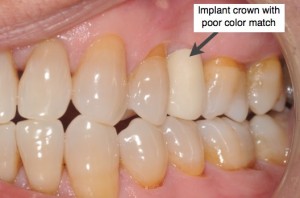Dark gray area around gum tissue:
 This is a common complication that results in poor aesthetics and patient awareness. It is best prevented by thorough diagnostics and planning by the oral surgeon and the restoring dentist. The right technique and choice of the right materials can prevent this problem. Darkness at the level of the gum tissue can be caused by:
This is a common complication that results in poor aesthetics and patient awareness. It is best prevented by thorough diagnostics and planning by the oral surgeon and the restoring dentist. The right technique and choice of the right materials can prevent this problem. Darkness at the level of the gum tissue can be caused by:
- Bone and gum tissue loss (recession) which results in exposure of the implant surface
- Use of metal abutments with thin type of gum tissue
Solution: If the darkness is due to mild recession, then a gum graft may help although the results are unpredictable. If the darkness is due to the metal abutment, then your dentist can change it to a ceramic (Zirconia) abutment and a full ceramic crown.
Color mis-match:
 The color of the crown must match the adjacent teeth for a natural and beautiful smile. Color mis-match is very unaesthetic as the crown looks fake and without life. This can be caused by poor color selection by your dentist or poor laboratory fabrication process.
The color of the crown must match the adjacent teeth for a natural and beautiful smile. Color mis-match is very unaesthetic as the crown looks fake and without life. This can be caused by poor color selection by your dentist or poor laboratory fabrication process.
Solution: The only solution is to remake the crown. Your dentist should first evaluate the color of your other teeth under regular or special office lighting. Then a detailed prescription must be written to the laboratory technician or master ceramist who will make the crown. This prescription can be accompanied with photos and models to help the technician in the process. Sometimes, the lab ceramist may actually come to the office and see the patient along with the dentist. This way they can better collaborate on the best color and design. The dentist should work with a very good quality laboratory who will take the time to create not just a tooth, but an art.
Gum recession:
 Gum recession results in very poor cosmetic results. Gum recession can be caused by gum disease, bone loss, or poorly positioned implant.
Gum recession results in very poor cosmetic results. Gum recession can be caused by gum disease, bone loss, or poorly positioned implant.
Solution: Gum grafting may be helpful but is relatively unpredictable. The restorative dentist may decide to make the crown with pink porcelain to camouflage the receded gum. Results are not perfect, but can be acceptable. If the recession is due to bone loss, then considerations should be given to removal of the implant, rebuilding of the bone, and replacement with a new implant. If the recession is caused by a poorly positioned dental implant, then it should be removed and replaced at a later time. Bone and gum tissue grafting may be necessary before a new implant is placed.
Tooth size discrepancy:
 The cosmetic result of any implant crown depends not only on the right color and position, but also on the right size and contours. A crown that is too big or small or poorly contoured for the space can be unaesthetic.
The cosmetic result of any implant crown depends not only on the right color and position, but also on the right size and contours. A crown that is too big or small or poorly contoured for the space can be unaesthetic.
Solution: Before the entire treatment, the surgeon and the restorative dentist should collaborate and share all diagnostic information to design an effective treatment plan. Photos, X-rays, cone beam ct scan, and models are necessary for proper diagnosis and planning. The dentist may order a wax-up prototype of the crowns even before the implants are placed to see how they might look and fit into the space. Customized abutments should be used all the time and avoid use of prefabricated abutments. The crown must be carefully fabricated by the laboratory with proper size, form, and fit. It is with consideration of all these factors that one can expect teeth that look and feel natural.
